With the introduction of all-new 14-inch and 16-inch MacBook Pro models, Apple has officially moved every laptop it sells away from Intel processors. The two-year transition to Apple Silicon is moving along well. Apple now sells three MacBook Pro models: A 13-inch model with the M1 processor, a 14-inch model with either the M1 Pro or M1 Max, and a 16-inch model with either the M1 Pro or M1 Max.
Even though the new M1 Pro and M1 Max processors seem rather incredible, these new laptops are about more than just a killer new processor. They’re full of great new features like a ProMotion HDR display and the return of beloved features like HDMI output and MagSafe that make the 13-inch model seem downright antiquated. So if you’re having trouble deciding which one to get, here’s how they compare.
Specs at a glance
We’ll discuss some of the more salient differences point-by-point, but first here are all the most important specs at a glance.
| 13″ MacBook Pro | 14″ MacBook Pro | 16″ MacBook Pro | |
|---|---|---|---|
| Starting Price | $1,299 | $1,999 | $2,499 |
| Maxed-out Price | $2,299 | $5,899 | $6,099 |
| Dimensions | 0.61 x 11.97 x 8.36 inches | 0.61 x 12.31 x 8.71 inches | 0.66 x 14.01 x 9.77 inches |
| Weight | 3 lbs (1.4 kg) | 3.5 lbs (1.6 kg) | 4.7 lbs (2.1 kg) |
| Processor | M1 | M1 Pro or M1 Max | M1 Pro or M1 Max |
| CPU | 8-core (4 efficiency, 4 performance) | 8- or 10-core (2 efficiency, 6 or 8 performance) | 10-core (2 efficiency, 8 performance) |
| GPU | 8-core | 14- or 16-core (M1 Pro), 24- or 32-core (M1 Max) | 16-core (M1 Pro), 24- or 32-core (M1 Max) |
| Neural Engine | 16-core (11 TOPS) | 16-core (11 TOPS) | 16-core (11 TOPS) |
| RAM | 8GB or 16GB, 68GB/sec | 16GB or 32GB, 200GB/sec (M1 Pro) 32GB or 64GB, 400GB/sec (M1 Max) | 16GB or 32GB, 200GB/sec (M1 Pro) 32GB or 64GB, 400GB/sec (M1 Max) |
| Storage | 256GB, 512GB, 1TB, 2TB | 512GB, 1TB, 2TB, 4TB, 8TB | 512GB, 1TB, 2TB, 4TB, 8TB |
| Display | 2560 x1 600, 500 nits, P3 wide color, True Tone | 3024 x 1964, 1,000 nits HDR (1,600 peak), P3 wide color, True Tone, 120Hz ProMotion | 3456 x 2234, 1,000 nits HDR (1,600 peak), P3 wide color, True Tone, 120Hz ProMotion |
| FaceTime camera | 720p | 1080p | 1080p |
| Ports | 2 Thunderbolt / USB4 ports | 3 Thunderbolt 4 ports, HDMI 2.0, SDXC card slot | 3 Thunderbolt 4 ports, HDMI 2.0, SDXC card slot |
| Battery Life | 17 hrs web, 20 hrs video | 11 hrs web, 17 hrs video | 14 hrs web, 21 hrs video |
| Power Adaptor | 61W USB-C | 67W or 96W USB-C with MagSafe | 140W USB-C with MagSafe |
The first thing you’ll notice is the staggering price difference between the year-old 13-inch MacBook Pro with M1 and the new 14-inch and 16-inch models. The starting price is over 50 percent higher, and even a fully-loaded 13-inch model barely costs more than the starting price of the 14-inch model.
But keep looking and you see where that money is going. In the newer MacBook Pro models get a choice of two processors, the lesser of which is nearly twice as capable as the M1. Starting storage is doubled, and maximum storage is quadrupled. The displays have the same pixel density but are larger, with thinner bezels, have HDR with exceptional brightness and contrast, and have ProMotion variable refresh rate technology up to 120Hz. There are more Thunderbolt ports, plus HDMI and an SD card slot.
In short, the new 14-inch and 16-inch MacBook Pros are vastly more expensive, but also vastly more capable in ways that go well beyond the processor.
13-inch MacBook Pro (M1, 2020)
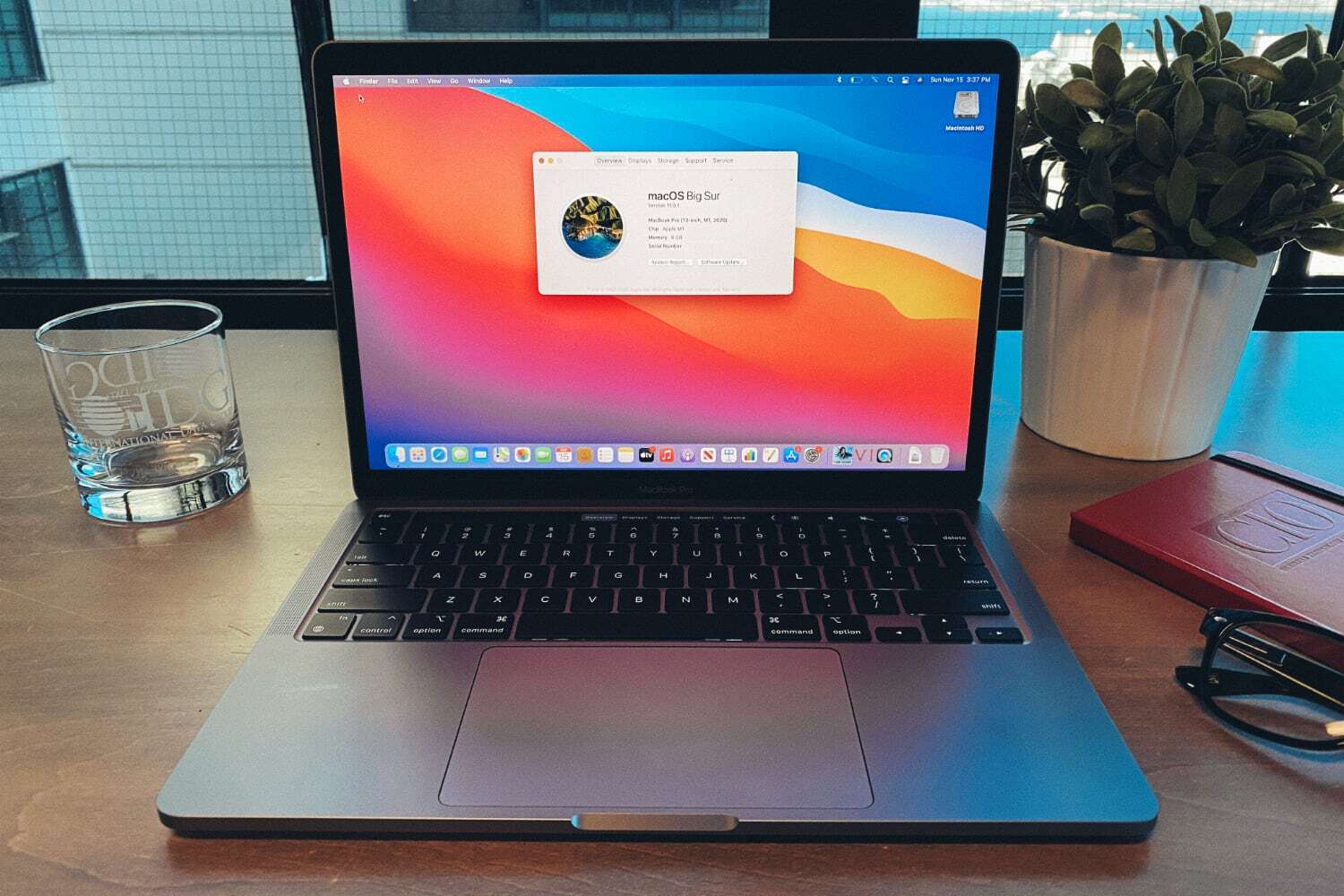 https://b2c-contenthub.com/wp-content/uploads/2021/04/Macbook-pro-m1-2020.jpg?resize=300%2C200&quality=50&strip=all 300w, https://b2c-contenthub.com/wp-content/uploads/2021/04/Macbook-pro-m1-2020.jpg?resize=768%2C512&quality=50&strip=all 768w, https://b2c-contenthub.com/wp-content/uploads/2021/04/Macbook-pro-m1-2020.jpg?resize=1200%2C800&quality=50&strip=all 1200w, https://b2c-contenthub.com/wp-content/uploads/2021/04/Macbook-pro-m1-2020.jpg?resize=1240%2C826&quality=50&strip=all 1240w, https://b2c-contenthub.com/wp-content/uploads/2021/04/Macbook-pro-m1-2020.jpg?resize=150%2C100&quality=50&strip=all 150w" sizes="(max-width: 300px) 100vw, 300px" />
https://b2c-contenthub.com/wp-content/uploads/2021/04/Macbook-pro-m1-2020.jpg?resize=300%2C200&quality=50&strip=all 300w, https://b2c-contenthub.com/wp-content/uploads/2021/04/Macbook-pro-m1-2020.jpg?resize=768%2C512&quality=50&strip=all 768w, https://b2c-contenthub.com/wp-content/uploads/2021/04/Macbook-pro-m1-2020.jpg?resize=1200%2C800&quality=50&strip=all 1200w, https://b2c-contenthub.com/wp-content/uploads/2021/04/Macbook-pro-m1-2020.jpg?resize=1240%2C826&quality=50&strip=all 1240w, https://b2c-contenthub.com/wp-content/uploads/2021/04/Macbook-pro-m1-2020.jpg?resize=150%2C100&quality=50&strip=all 150w" sizes="(max-width: 300px) 100vw, 300px" />A huge difference in performance
We’re impressed by the M1 processor released in several Mac models late in 2020…it absolutely sips power but is much faster than all but the most powerful Intel laptop chips. But the 13-inch model is stuck with that chip, and the only real option you have is between 8GB or 16GB of RAM.
The new MacBook Pro models give you way more options, starting with the processors. There’s the M1 Pro, which has double the high-performance CPU cores, double the GPU cores (16), and 3x the memory bandwidth, with options for 16GB or 32GB of RAM. Stepping up from that, you can get the M1 Max, which has the same CPU but doubles again the GPU cores (32), memory bandwidth (400GB/sec), and memory (32GB or 64GB).
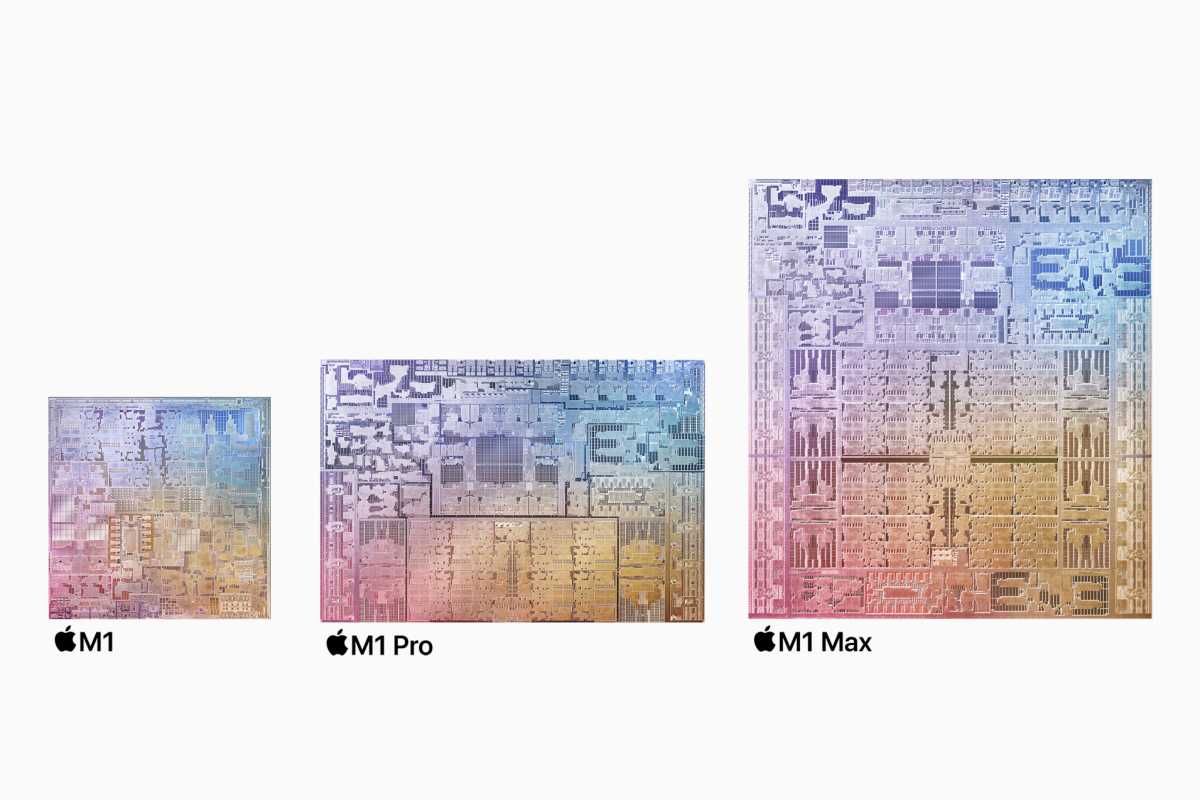 https://b2c-contenthub.com/wp-content/uploads/2021/10/apple-m1-family.jpg?resize=300%2C200&quality=50&strip=all 300w, https://b2c-contenthub.com/wp-content/uploads/2021/10/apple-m1-family.jpg?resize=768%2C512&quality=50&strip=all 768w, https://b2c-contenthub.com/wp-content/uploads/2021/10/apple-m1-family.jpg?resize=1200%2C800&quality=50&strip=all 1200w, https://b2c-contenthub.com/wp-content/uploads/2021/10/apple-m1-family.jpg?resize=1536%2C1024&quality=50&strip=all 1536w, https://b2c-contenthub.com/wp-content/uploads/2021/10/apple-m1-family.jpg?resize=1240%2C826&quality=50&strip=all 1240w, https://b2c-contenthub.com/wp-content/uploads/2021/10/apple-m1-family.jpg?resize=150%2C100&quality=50&strip=all 150w" width="1200" height="800" sizes="(max-width: 1200px) 100vw, 1200px" />
https://b2c-contenthub.com/wp-content/uploads/2021/10/apple-m1-family.jpg?resize=300%2C200&quality=50&strip=all 300w, https://b2c-contenthub.com/wp-content/uploads/2021/10/apple-m1-family.jpg?resize=768%2C512&quality=50&strip=all 768w, https://b2c-contenthub.com/wp-content/uploads/2021/10/apple-m1-family.jpg?resize=1200%2C800&quality=50&strip=all 1200w, https://b2c-contenthub.com/wp-content/uploads/2021/10/apple-m1-family.jpg?resize=1536%2C1024&quality=50&strip=all 1536w, https://b2c-contenthub.com/wp-content/uploads/2021/10/apple-m1-family.jpg?resize=1240%2C826&quality=50&strip=all 1240w, https://b2c-contenthub.com/wp-content/uploads/2021/10/apple-m1-family.jpg?resize=150%2C100&quality=50&strip=all 150w" width="1200" height="800" sizes="(max-width: 1200px) 100vw, 1200px" />Apple
These chips should make for an absolutely massive increase in performance. Apple says to expect 70 percent better CPU performance and double the GPU performance (or 4x in the M1 Max) over the M1, and given the increase in memory bandwidth, we think that’s probable.
In the 14-inch version, the entry-level model has an M1 Pro with two high-performance CPU cores disabled and two GPU cores disabled, for a total of 8 CPU and 14 GPU cores. That reduced-performance chip is not available on the 16-inch model. If you want the full M1 Pro on the 14-inch MacBook Pro, you have to spend $300 more or you can get a 10-core CPU with a 14-core CPU for $200 more.
A big difference in display quality
There’s nothing wrong with the display on the 13-inch MacBook Pro. It’s got excellent resolution (227 pixels per inch), color depth, and accuracy. But Apple has been quite behind the times in adopting HDR and high-refresh rates on its laptops, while Windows laptops have offered these technologies for years.
The new 14 and 16-inch MacBook Pro changes all that. The display still has the same resolution (227 pixels per inch) but it’s larger, with slimmer bezels all around. More importantly, they use thousands of mini-LED backlights for better energy efficiency, contrast, and brightness. With SDR content they still top out at 500 nits, but with HDR content the new displays can go up to 1,000 nits sustained and 1,600 nits peak. That’s incredible HDR performance that beats nearly any other laptop display on the market.
ProMotion is a game-changer, as it brings 120Hz high refresh rates to the MacBook Pro (finally!), but also allows for dynamic variable refresh rates down to 24Hz, which is not only great for movie-watching, it’s a big benefit to battery life.
14-inch MacBook Pro (2021)
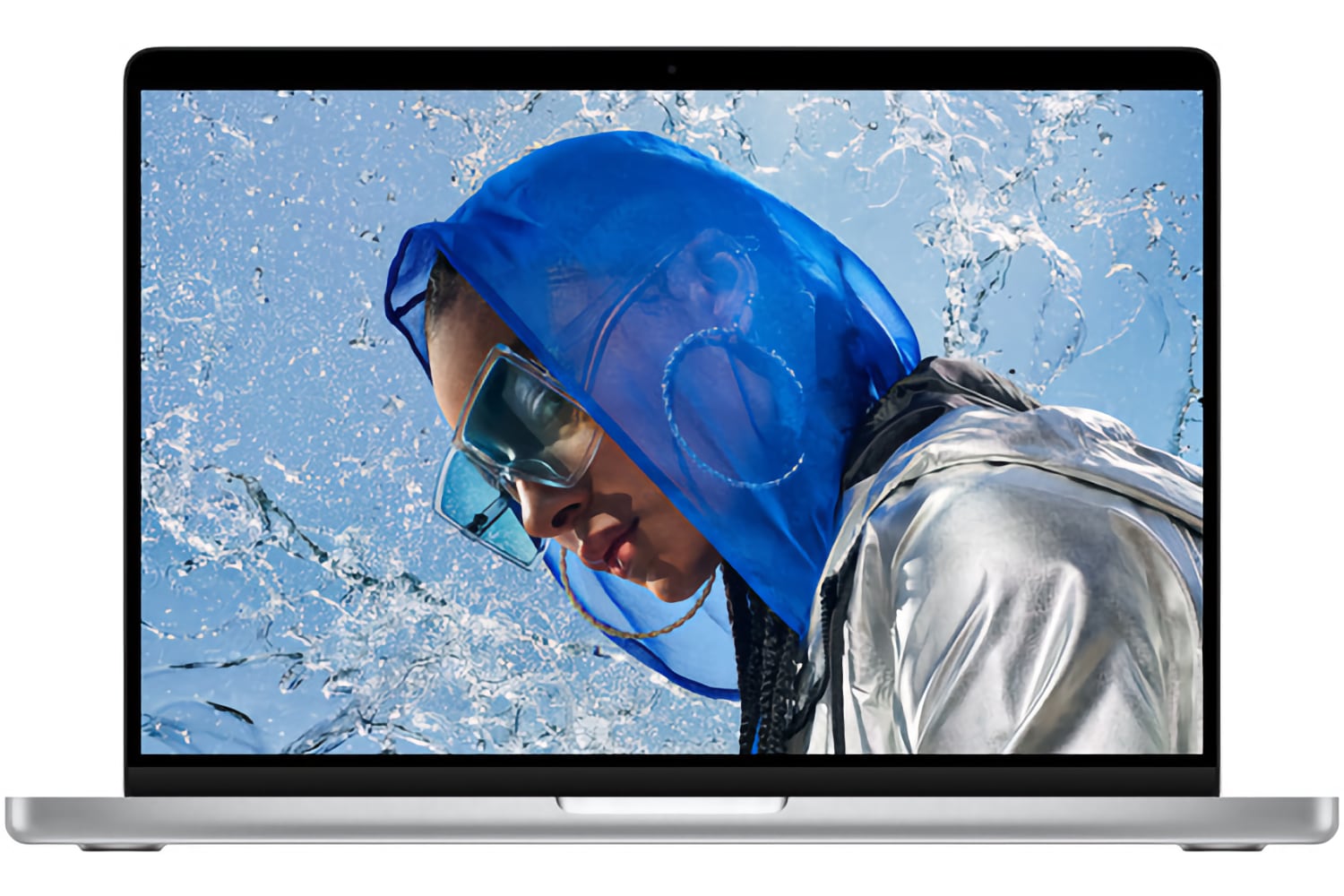 https://b2c-contenthub.com/wp-content/uploads/2021/10/14-inch-macbook-pro.jpg?resize=300%2C200&quality=50&strip=all 300w, https://b2c-contenthub.com/wp-content/uploads/2021/10/14-inch-macbook-pro.jpg?resize=768%2C512&quality=50&strip=all 768w, https://b2c-contenthub.com/wp-content/uploads/2021/10/14-inch-macbook-pro.jpg?resize=1200%2C800&quality=50&strip=all 1200w, https://b2c-contenthub.com/wp-content/uploads/2021/10/14-inch-macbook-pro.jpg?resize=1240%2C826&quality=50&strip=all 1240w, https://b2c-contenthub.com/wp-content/uploads/2021/10/14-inch-macbook-pro.jpg?resize=150%2C100&quality=50&strip=all 150w" sizes="(max-width: 300px) 100vw, 300px" />
https://b2c-contenthub.com/wp-content/uploads/2021/10/14-inch-macbook-pro.jpg?resize=300%2C200&quality=50&strip=all 300w, https://b2c-contenthub.com/wp-content/uploads/2021/10/14-inch-macbook-pro.jpg?resize=768%2C512&quality=50&strip=all 768w, https://b2c-contenthub.com/wp-content/uploads/2021/10/14-inch-macbook-pro.jpg?resize=1200%2C800&quality=50&strip=all 1200w, https://b2c-contenthub.com/wp-content/uploads/2021/10/14-inch-macbook-pro.jpg?resize=1240%2C826&quality=50&strip=all 1240w, https://b2c-contenthub.com/wp-content/uploads/2021/10/14-inch-macbook-pro.jpg?resize=150%2C100&quality=50&strip=all 150w" sizes="(max-width: 300px) 100vw, 300px" />Speakers, mics, and headphones
The speakers in the 13-inch M1 MacBook Pro are fine, but the new models have a six-speaker sound system that promises much better fidelity and support for Spatial Audio. All the MacBook Pros have a beamforming three-mic array, but the new models have improved sensitivity and a lower noise floor, so recordings should sound better.
And while there’s a headphone jack on all the MacBook Pros, the new 14 and 16-inch models specifically support high-impedance headphones. That’s great for studio headphones, which need more power to drive them.
A better webcam, and a notch
The 720p Facetime camera on most macs, including the 13-inch MacBook Pro, has been a thorn in our side for far too long. Apple talks a lot about how improved image processing in the M1 chip makes the camera better, and it does, but it’s still a crummy and out-of-date piece of hardware.
The new MacBook Pros have a 1080p webcam. But more important than the resolution improvement is the new optics with a wider aperture. It’s probably the same hardware as on the M1 iMac, which impressed us with its webcam quality.
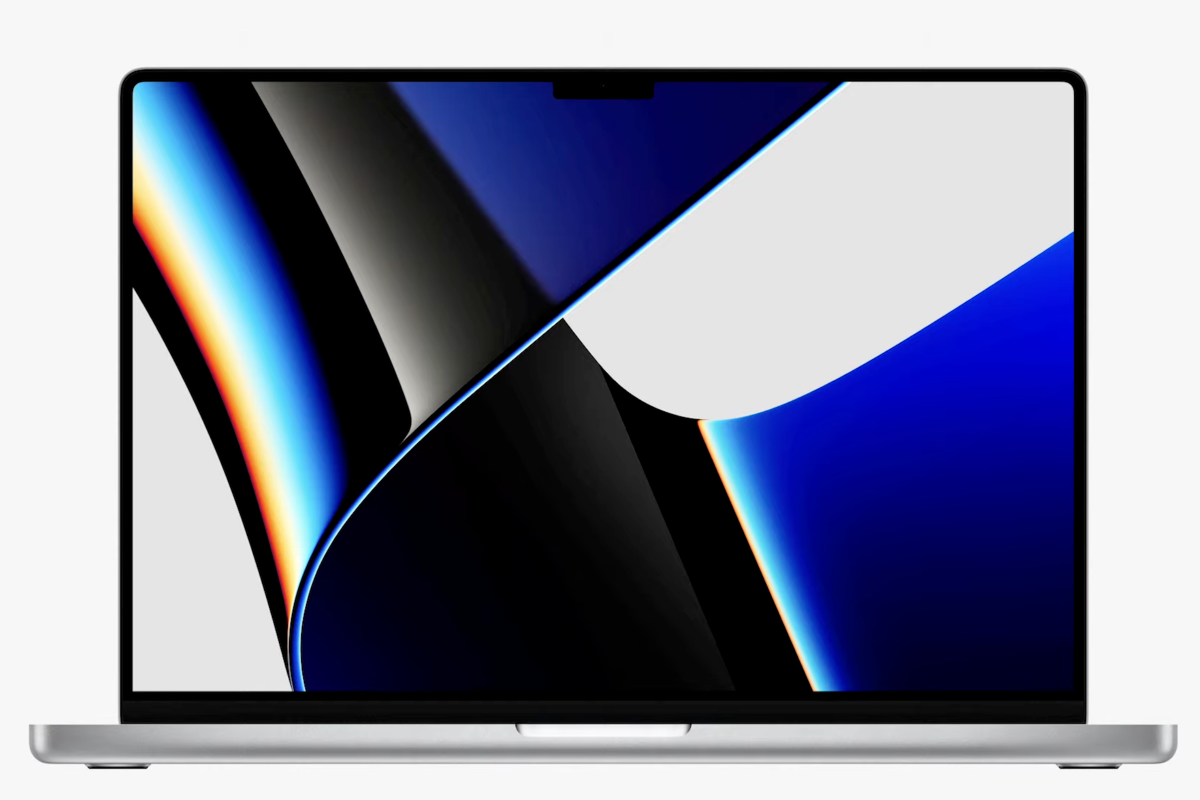 https://b2c-contenthub.com/wp-content/uploads/2021/10/MacBook-Pro.png?resize=300%2C200&quality=50&strip=all 300w, https://b2c-contenthub.com/wp-content/uploads/2021/10/MacBook-Pro.png?resize=768%2C512&quality=50&strip=all 768w, https://b2c-contenthub.com/wp-content/uploads/2021/10/MacBook-Pro.png?resize=1200%2C800&quality=50&strip=all 1200w, https://b2c-contenthub.com/wp-content/uploads/2021/10/MacBook-Pro.png?resize=1536%2C1024&quality=50&strip=all 1536w, https://b2c-contenthub.com/wp-content/uploads/2021/10/MacBook-Pro.png?resize=2048%2C1365&quality=50&strip=all 2048w, https://b2c-contenthub.com/wp-content/uploads/2021/10/MacBook-Pro.png?resize=1240%2C826&quality=50&strip=all 1240w, https://b2c-contenthub.com/wp-content/uploads/2021/10/MacBook-Pro.png?resize=150%2C100&quality=50&strip=all 150w" width="1200" height="800" sizes="(max-width: 1200px) 100vw, 1200px" />
https://b2c-contenthub.com/wp-content/uploads/2021/10/MacBook-Pro.png?resize=300%2C200&quality=50&strip=all 300w, https://b2c-contenthub.com/wp-content/uploads/2021/10/MacBook-Pro.png?resize=768%2C512&quality=50&strip=all 768w, https://b2c-contenthub.com/wp-content/uploads/2021/10/MacBook-Pro.png?resize=1200%2C800&quality=50&strip=all 1200w, https://b2c-contenthub.com/wp-content/uploads/2021/10/MacBook-Pro.png?resize=1536%2C1024&quality=50&strip=all 1536w, https://b2c-contenthub.com/wp-content/uploads/2021/10/MacBook-Pro.png?resize=2048%2C1365&quality=50&strip=all 2048w, https://b2c-contenthub.com/wp-content/uploads/2021/10/MacBook-Pro.png?resize=1240%2C826&quality=50&strip=all 1240w, https://b2c-contenthub.com/wp-content/uploads/2021/10/MacBook-Pro.png?resize=150%2C100&quality=50&strip=all 150w" width="1200" height="800" sizes="(max-width: 1200px) 100vw, 1200px" />Apple
Unfortunately, the wide-angle camera with support for Center Stage remains an iPad-only technology, for some reason. So, while the new MacBook Pros have a much better webcam and that’s great, it’s still not the one we really want.
The new webcam is housed in a pretty significant-sized notch at the top of the display. Despite looking very much like that on the iPhone, it’s not a TrueDepth sensor. There’s no Face ID or Animoji or anything like that. The notch doesn’t actually cut into the main display area, though. The area beneath the notch is a 16×10 display, just like all prior MacBooks. The display area on either side of the notch extends upward from there, adding screen area on top of the 16×10 rectangle. The menu bar is located in that area, effectively giving you more vertical space for all your apps. Developers can choose to use that extra screen space if they want to.
16-inch MacBook Pro (2021)
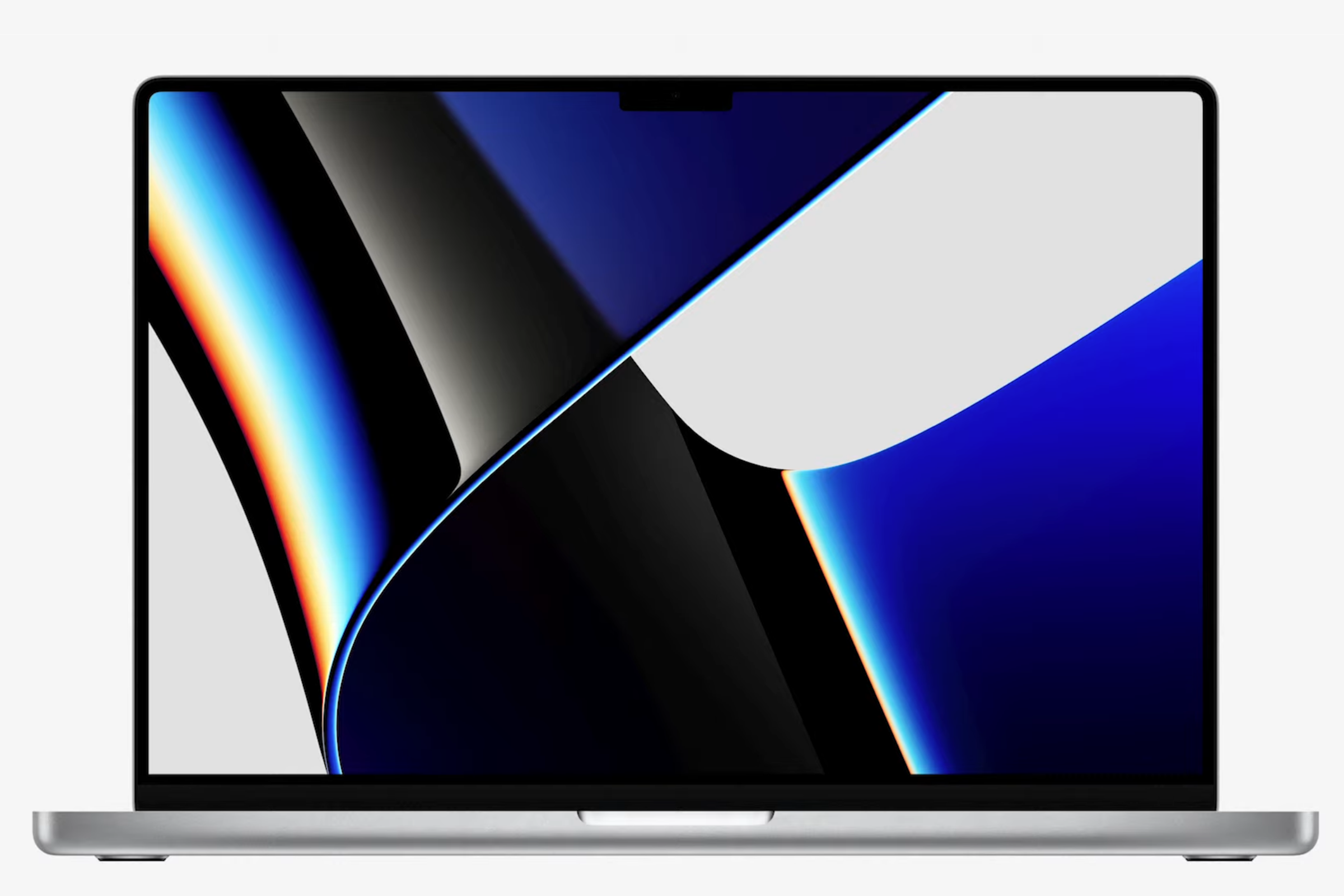 https://b2c-contenthub.com/wp-content/uploads/2021/10/MacBook-Pro.png?resize=300%2C200&quality=50&strip=all 300w, https://b2c-contenthub.com/wp-content/uploads/2021/10/MacBook-Pro.png?resize=768%2C512&quality=50&strip=all 768w, https://b2c-contenthub.com/wp-content/uploads/2021/10/MacBook-Pro.png?resize=1200%2C800&quality=50&strip=all 1200w, https://b2c-contenthub.com/wp-content/uploads/2021/10/MacBook-Pro.png?resize=1536%2C1024&quality=50&strip=all 1536w, https://b2c-contenthub.com/wp-content/uploads/2021/10/MacBook-Pro.png?resize=2048%2C1365&quality=50&strip=all 2048w, https://b2c-contenthub.com/wp-content/uploads/2021/10/MacBook-Pro.png?resize=1240%2C826&quality=50&strip=all 1240w, https://b2c-contenthub.com/wp-content/uploads/2021/10/MacBook-Pro.png?resize=150%2C100&quality=50&strip=all 150w" sizes="(max-width: 300px) 100vw, 300px" />
https://b2c-contenthub.com/wp-content/uploads/2021/10/MacBook-Pro.png?resize=300%2C200&quality=50&strip=all 300w, https://b2c-contenthub.com/wp-content/uploads/2021/10/MacBook-Pro.png?resize=768%2C512&quality=50&strip=all 768w, https://b2c-contenthub.com/wp-content/uploads/2021/10/MacBook-Pro.png?resize=1200%2C800&quality=50&strip=all 1200w, https://b2c-contenthub.com/wp-content/uploads/2021/10/MacBook-Pro.png?resize=1536%2C1024&quality=50&strip=all 1536w, https://b2c-contenthub.com/wp-content/uploads/2021/10/MacBook-Pro.png?resize=2048%2C1365&quality=50&strip=all 2048w, https://b2c-contenthub.com/wp-content/uploads/2021/10/MacBook-Pro.png?resize=1240%2C826&quality=50&strip=all 1240w, https://b2c-contenthub.com/wp-content/uploads/2021/10/MacBook-Pro.png?resize=150%2C100&quality=50&strip=all 150w" sizes="(max-width: 300px) 100vw, 300px" />Connectivity and expansion galore
The ports are back!
Years ago, Apple got rid of our beloved MagSafe charging connector, opting instead to take up one of the few Thunderbolt ports for charging. And they got rid of the SD card slot and HDMI port, too. That’s how it is with the 13-inch Pro—you get just two Thunderbolt ports, a headphone jack, and nothing else.
With the new MacBook Pro models, Apple has given us one additional Thunderbolt port, and it brought back the HDMI port, SDXC card slot, and MagSafe connector. Somewhat confusingly, the company also uses MagSafe as the brand for the iPhone’s magnetic charging and accessory attachment technology, which is sort of a different thing but also involves magnetic charging.
Yeah, we wish the HDMI port supported HDMI 2.1 (it’s HDMI 2.0, so it tops out at 4K and 60Hz), but this is still a huge leap in the right direction–backward!
Bye-bye Touch Bar
The 13-inch MacBook Pro with an M1 processor is only available with the Touch Bar—and now it’s the only Mac that has it. The new 14 and 16-inch MacBook Pros are only available without it! Instead, Apple gives you a full-height row of Function keys with a Touch ID sensor at the right.
I’ll leave you to decide which one is better, but both systems have a Touch ID button in the upper right of the keyboard like the iMac’s Magic Keyboard with Touch ID.
 https://b2c-contenthub.com/wp-content/uploads/2021/10/macbook-pro-function-keys-2021.jpg?resize=300%2C200&quality=50&strip=all 300w, https://b2c-contenthub.com/wp-content/uploads/2021/10/macbook-pro-function-keys-2021.jpg?resize=768%2C512&quality=50&strip=all 768w, https://b2c-contenthub.com/wp-content/uploads/2021/10/macbook-pro-function-keys-2021.jpg?resize=1200%2C800&quality=50&strip=all 1200w, https://b2c-contenthub.com/wp-content/uploads/2021/10/macbook-pro-function-keys-2021.jpg?resize=1240%2C826&quality=50&strip=all 1240w, https://b2c-contenthub.com/wp-content/uploads/2021/10/macbook-pro-function-keys-2021.jpg?resize=150%2C100&quality=50&strip=all 150w" width="1200" height="800" sizes="(max-width: 1200px) 100vw, 1200px" />
https://b2c-contenthub.com/wp-content/uploads/2021/10/macbook-pro-function-keys-2021.jpg?resize=300%2C200&quality=50&strip=all 300w, https://b2c-contenthub.com/wp-content/uploads/2021/10/macbook-pro-function-keys-2021.jpg?resize=768%2C512&quality=50&strip=all 768w, https://b2c-contenthub.com/wp-content/uploads/2021/10/macbook-pro-function-keys-2021.jpg?resize=1200%2C800&quality=50&strip=all 1200w, https://b2c-contenthub.com/wp-content/uploads/2021/10/macbook-pro-function-keys-2021.jpg?resize=1240%2C826&quality=50&strip=all 1240w, https://b2c-contenthub.com/wp-content/uploads/2021/10/macbook-pro-function-keys-2021.jpg?resize=150%2C100&quality=50&strip=all 150w" width="1200" height="800" sizes="(max-width: 1200px) 100vw, 1200px" />Apple
Battery Life
While the new 14 and 16-inch MacBook Pros have really excellent battery life specs, especially when you consider the much bigger and faster processors, more RAM, and better displays, it’s not quite as stellar as the older 13-inch model.
Call it a benefit of having an M1 chip that is half as powerful as the M1 Pro and a quarter as powerful as the M1 Max…you get more life out of the battery. The 13-inch M1 model has a 58.2Wh battery and can go 20 hours of watching video, while the 70Wh battery in the 14-inch model will keep it going for 17 hours and the 16-inch model gets 21 hours of video playback out of its 100Wh battery.
Another note: The entry-level 14-inch MacBook Pro comes with a 67W power adaptor, with an option for a 96W adapter. The 96W model is necessary for fast charging and comes standard with all other configurations. Otherwise, it’s a $20 upgrade. The 16-inch model comes with a 140W power adapter in all configurations.
The 13-inch MacBook Pro has a less powerful 61W power adapter, but it also has a significantly smaller battery to charge. It doesn’t support fast charging.
Conclusion
On paper, the new 14-inch and 16-inch MacBook Pros absolutely crush the 13-inch MacBook Pro, and we expect the benchmarks and real-world use to bear that out. They have better processors, better displays, more ports, and a better webcam. But it also has a $700 higher starting price and is missing the Touch Bar, a feature that once set Apple’s pro laptops apart from its non-pro ones. Take the Touch Bar away from the 13-inch MacBook Pro and it’s basically a MacBook Air.
We’re not sure what Apple is going to do with the 13-inch MacBook Pro. It’s possible that Apple gives it an M2 chip next year and a design that matches the new models, but the new Pro models appear to indicate that Apple is looking to create more space between the low-end and high-end laptops. And having two models so close in size seems unnecessary. So we wouldn’t be surprised to see the 13-inch Pro removed from the lineup next year. So if you like the Touch Bar, you should probably grab a 13-inch Pro while you still can.
But for everyone else, the 14-inch or 16-inch MacBook Pro is the absolute pinnacle of the portable Mac. We recommend getting as much RAM and storage as you can afford—the sweet spot for most people will be the 10-core/16-core M1 Pro with 32GB of RAM and 1TB of storage—but we’re confident that you’ll be happy with any of the configurations Apple offers. We would avoid the 8-core entry-level model for future-proofing’s sake, but if that’s all your budget will allow, it’ll still be plenty fast for years to come.






